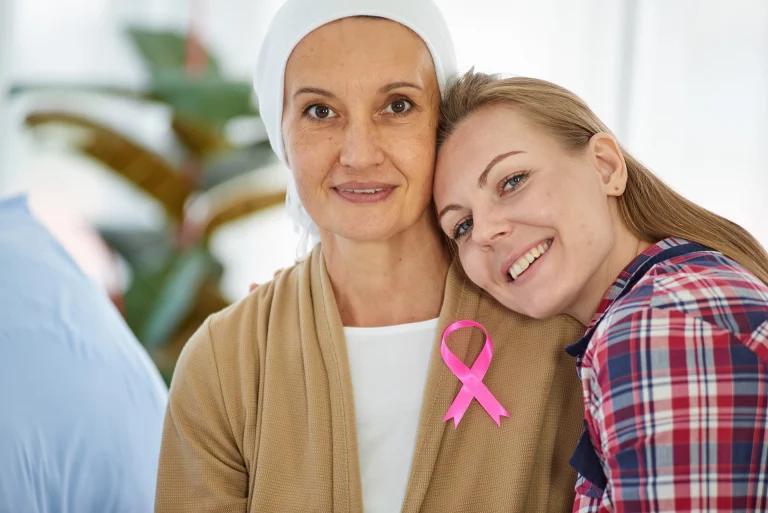Lymphoma is a blood cancer originating in white blood cells (lymphocytes) in the lymphatic system. In many cases the first sign of this type of cancer are enlarged lymph nodes in areas such as the sides of the neck, in the groin, underarm areas or above the collar bone. Lymphoma symptoms vary depending on the type of lymphoma. Not everyone gets the same symptoms, but there are some common signs of lymphoma to look out for. Read on to find out more.
📝 The lymphatic system
The lymphatic system operates as part of the body’s immune system, which protects against infection and disease. White blood cells (lymphocytes) play an important role in fighting disease.
The lymphatic system also maintains fluid balance, aids in digestion and acts as your body’s natural detox system by clearing out waste and toxins. The lymphatic system includes the spleen, thymus, lymph nodes and lymph channels, as well as the tonsils and adenoids. The six lymphatic points in the body are:
- Collar bone (both sides)
- Behind the angle of your jaw
- Shoulder joint/armpit region
- Abdomen
- Groin area
- Behind your knee
📝 What is lymphoma?
There are two types of lymphocytes or white blood cells called T cells and B cells. In lymphoma something goes wrong when a single lymphocyte undergoes an unnatural change (mutation) and becomes a cancerous lymphoma cell. Eventually healthy cells are crowded out and cancerous lymphoma cells multiply and build-up in the lymph nodes and other parts of the body.
📝 Different types of lymphoma
Hodgkin lymphoma (HL)
Classic Hodgkin lymphoma is the most common form of this disease, typically starting above the diaphragm in the neck, armpits, or chest.
Non-Hodgkin lymphomas (NHL)
The two most common subtypes of non-Hodgkin lymphoma are diffuse large B-cell lymphoma and follicular lymphoma. B cell lymphoma is a fast-growing lymphoma and follicular lymphoma is slow growing cancer.
🏥 Common lymphoma symptoms
Most people with these symptoms won’t have lymphoma. But some people will, and the sooner you’re diagnosed, the sooner you can get the right care.
Swollen lymph nodes
According to The American Cancer Society swollen lymph nodes are the most common symptom of lymphoma. Enlarged lymph nodes can appear in the neck, upper chest, armpit, groin area, or anywhere you have glands (lymph nodes). They are usually painless swellings, round in shape, with a smooth rubbery texture. They usually move out of the way when you press on them, but can sometimes ache or cause pain in nearby areas e.g. when pressing on a nerve.
Extreme tiredness
Fatigue is another common symptom of any type of lymphoma. It’s feeling extremely tired, even when you’ve had plenty of rest. This symptom make it difficult for you to complete your daily tasks.
It’s important to remember fatigue is a general symptom of many medical conditions, medications, or lifestyle habits. If you have lymphoma, your fatigue can be caused by the disease itself, a side effect of lymphoma treatment, or an unrelated health issue.
Chest pain, cough or breathlessness
If there’s a swelling in your chest symptoms such as shortness of breath, chest pain and a cough may develop. This is due to swollen lymph nodes located in the chest compressing nearby organs such as the windpipe.
Feeling full or feeling sick
Lymphoma may cause bloating, abdominal pain and loss of appetite if you have a buildup of fluid in your abdomen or your spleen is enlarged. Bloating and abdominal pressure can also be caused by lymphoma of the genital tract.
Itchy skin
This symptom can either be widespread or in one place. The reason for this is unknown.
Bone pain
If the lymphoma affects the bone marrow inside your bones it can cause bone pain. It can also reduce the number of red blood cells causing tiredness. Bone marrow is a spongy material in the middle of bones where blood cells are made.
Frequent infections
This is usually caused by low levels of white blood cells in the body. Persistent, reoccurring and severe infections, plus a high temperature can indicate the presence of lymphoma.
Unusual bleeding, bruising and rashes
This is caused by a low number of platelets, the blood cells that cause the blood to clot. They may appear as small spots or discoloured patches on the skin. Nose bleeds, heavy periods or gum bleeding may also be seen.
What are B symptoms?
There are three symptoms, called B symptoms that are also symptoms of lymphoma that are used by healthcare professionals to help stage and create treatment plans:
- High fever (38°C or higher)
Fever persist for days to weeks and then goes.
- Unexplained weight loss
- If you’ve lost 10% of your total body weight over six months without dieting or exercise this can be a sign. Lymphoma can alter the body’s metabolism and reduce muscle and fat.
- Night sweats which drench your nightclothes and bedding.
Whether or not someone has B symptoms is a guide to how much the lymphoma has developed. This helps doctors assess the stage of the lymphoma and decide on the best treatment.
❗ Risk factors
Like most cancers, the majority of the genetic mutations that cause lymphoma happen spontaneously, without a clear cause. Some conditions or issues may increase your risk of developing lymphoma:
- Age
- Gender, with it being more common in males
- Having a medical condition that already weakens your immune system
- Family history
- Previous exposure to the Epstein-Barr/Herpes viruses
🔬 Diagnosis
A blood cancer diagnosis usually involves referral to oncology, but initially by a GP:
- Physical exam to check for swollen lymph nodes
- Blood tests to rule out other forms of infection or disease
- A biopsy involving removal of a sample of lymph nodes to test for cancerous cells
- CT/MRI scans
- Bone marrow biopsy
- Lumbar puncture
💊 Treatment options
Lymphoma treatment involves a range of different options depending on discussion with a healthcare provider. Treatment plans focus on helping people to have a good quality of life and successful management of the condition.
- Chemotherapy. Oral or IV medication that targets and kills cancerous cells. It can be used as a stand alone cancer treatment or combined with radiation therapy and biological therapy
- Radiation therapy. Commonly used for early stage cancer where a localised source of lymphoma has been found. It uses high energy beams to kill cancer cells
- Immunotherapy. This therapy is used to change immune cells in your system to help fight the cancer cells
- Bone marrow transplants
- Other methods of treatment, including a stem cell transplant, alternative drugs, or drug combinations
Side effects of treatment
Lymphoma treatments may have different side effects because people often have different reactions to the same treatment. Your healthcare provider can provide information about treatment side effects and support services.
📝 Conclusion
Lymphoma can start almost anywhere in your body and cause many different symptoms. The exact symptoms depend on the type of lymphoma and its location on the body. You may have lots of the symptoms discussed above or very few of them. If you are concerned about any of these symptoms speak to your GP. Also keep a diary of symptoms, how you feel and any noticeable changes. This will help when your see your doctor. These symptoms do not always mean you have lymphoma. However, it is important to discuss any signs with your doctor, since they may signal other health problems.
Sources
- Lymphoma symptoms and signs – Blood Cancer UK
- About Lymphoma of the Skin – Lymphoma of the Skin Overview – American Cancer Society
- Symptoms of Hodgkin lymphoma – Cancer Research UK
- Non-Hodgkin lymphoma – Cancer Research UK
- Non-Hodgkin lymphoma – Symptoms – NHS
- Hodgkin lymphoma – NHS
Medical Disclaimer
NowPatient has taken all reasonable steps to ensure that all material is factually accurate, complete, and current. However, the knowledge and experience of a qualified healthcare professional should always be sought after instead of using the information on this page. Before taking any drug, you should always speak to your doctor or another qualified healthcare provider.
The information provided here about medications is subject to change and is not meant to include all uses, precautions, warnings, directions, drug interactions, allergic reactions, or negative effects. The absence of warnings or other information for a particular medication does not imply that the medication or medication combination is appropriate for all patients or for all possible purposes.







